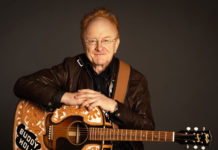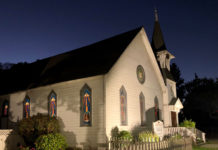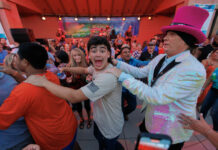Ansel Adams is famous for capturing in his photographic images
the grandeur of the American wilderness. But surprisingly, his
early works
– now on display at a special San Jose Museum of Art exhibition
– look like snapshots an amateur photographer on vacation might
have taken with a cell-phone camera.
Ansel Adams is famous for capturing in his photographic images the grandeur of the American wilderness. But surprisingly, his early works – now on display at a special San Jose Museum of Art exhibition – look like snapshots an amateur photographer on vacation might have taken with a cell-phone camera.
I felt pleased at this surprising revelation when I recently visited the SJMA. Adams stands on a pedestal as the quintessence of great American camera artists. So it’s reassuring to see that, in his younger days, he created extremely uninteresting images. The current SJMA exhibition “Ansel Adams: Early Works” proves the master wasn’t a born photographic genius. He began his career as an amateur. In his early years, he produced boring images of unexceptional camera technique.
Adams’ true genius was that he applied himself to mastering the camera. Halfway through the SJMA gallery showing his early works, his photographs leave the snapshot realm and lift into lofty heights expressing the mystical plane of nature. His images become crisp, bold artworks shining with a spiritual luminescence. Somehow through years of diligent practice that perfected his technique, Adams left the amateur level and discovered how to create images capturing the soul of creation.
Adams lived his last years in the Carmel Highlands. He knew the South Valley region well. Occasionally, he visited the Mission San Juan Bautista to teach local youngsters the fundamentals of photography. His favorite South Valley eating house to stop for a bite after a photographic jaunt in the Sierras was Hollister’s Sugar Plum Farm Restaurant (now the Cedar House).
I suspect if he were alive today (he died in 1984), Adams might visit the Morgan Hill Photography Club to provide friendly advice to South Valley camera buffs. The club was started two years ago by retired teacher and photography fanatic Susan Brazelton. When she first proposed a South Valley photography club, she wondered how many people might join. I told her five would be the maximum. Boy, was I wrong. At the first meeting, more than 20 people joined. The club now numbers 100-plus members. It’s clear lots of camera buffs live in the South Valley.
The hobby of photography is extremely popular in our region. One reason is that we are blessed with an abundance of photogenic locations. The village of San Juan Bautista, the Pinnacles National Monument, Uvas Canyon, Henry Coe State Park, the Monterey Bay area – all provide a feast for the photographic lens.
Inexpensive digital cameras and camera options on cell phones have also made photography accessible for most people. I love the instant gratification I get seeing my images on my Olympus Evolt LCD screen seconds after taking a shot. I’m not pleased with the picture I snapped? I simply hit the erase button and try again. Computer software like Photoshop also lets me enhance images to compare to those created by professional photographers with years of camera experience.
Despite the advantages of digital cameras, most people take ordinary amateur snapshots rather than create inspiring photographic works of art. As shown by the “Early Works” exhibit, Adams somehow moved from amateur to professional-level artist by discovering how to encapsulate a soul essence in his images. He once described his philosophy as “making” photographs instead of simply “taking” photographs. Great images are not merely documenting a landscape, person or object. Great images are an act of inspired creation. Adams once observed, “It’s easy to take a photograph, but it is harder to make a masterpiece in photography than in any other art medium.”
Adams’ masterpieces such as “Moonrise, Henderson, New Mexico” and “Clearing Winter Storm, Yosemite” contain a heightened sense of dramatic tension. They make you feel you’re part of a story climaxing at a mysterious frozen moment of emotional truth. That artistic achievement isn’t easy to pull off.
My own camera work is far from Adams’ level. But thanks to the Morgan Hill Photography Club, I’ve evolved as a photographer. I learn advanced camera techniques from the professional photographers who are club members – including one who spent hours in a darkroom learning printing with Adams. I’m also inspired by images shared by members on the club’s Flickr photo-sharing Web site (www.flickr.com/groups/mhphotoclub).
Club members might not produce photographs on the caliber of Adams’ masterpieces. But you can make a case that many of their best images surpass in composition and camera skill some of his early works now displayed at the SJMA. I think Adams would agree. He would be mighty impressed by the creative camera work coming out of the South Valley.
Visit morganhillphotographyclub.org for more club information. And check out the club’s nature-themed gallery show at the Morgan Hill Community Center running Feb. 24 to April 9.







